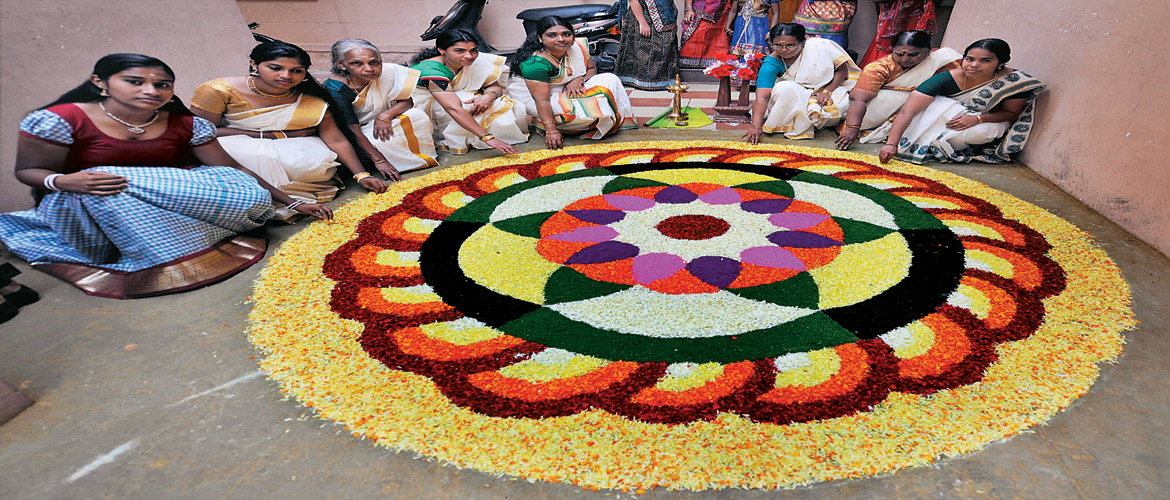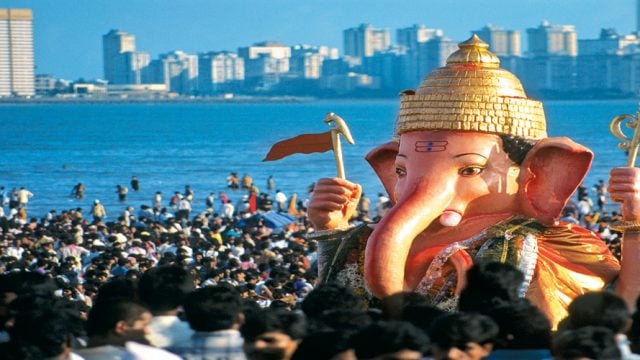Type Harvest Festival Time 10 Days In August/September Location Kerala Kanam vittum onam unnanam
Although folklore tends to ascribe the origin of the festival to the Hindu myth of Mahabali, people of all religions and creeds celebrate it. In fact, it is the state festival of Kerala.
Legend has it that Mahabali, an asura (demon) king who once ruled Kerala, was an exemplar of good governance. His subjects were happy and prosperous. Mahabali’s popularity made the devas (gods) jealous, who vowed to dethrone him. Lord Vishnu took the form of a dwarf priest (vamana) and went to the king’s court to seek his help. He requested the emperor to gift him three steps worth of land, to which Mahabali readily assented. Then, Vishnu grew exponentially in size and covered the entire world in two steps. When he asked the king where he could take the third step, Mahabali, unable to fulfill his promise, offered his head. Vishnu stepped on it and pushed him to the nether-world. However, for his humility, Vishnu allowed him to visit his kingdom once a year to ensure his subjects’ prosperity, who in turn, celebrate Onam to welcome and honour him.
The festival begins on the Atham asterism in the Malayalam month of Chingam (August–September). On this day, Athachamayam, a carnival in Tripunithura town of Ernakulam District, jumpstarts the festivities. The procession to Tripunithura Fort, held to commemorate the victory of a king of Kochi, features caparisoned elephants, impressive pyrotechnic displays and a plethora of folk art and music performances. The Vamana temple in Thrikkakara (literally ‘the place where the lord set his foot’), which is believed to be the capital of Mahabali’s kingdom, is also a hub of revelries.
While the Onam celebrations and rituals vary from region to region in the state, there are some common features. People welcome Mahabali by making beautiful designs using fresh flowers (pookalam) in front of their houses. Near the pookalam, they place an idol of Thrikkakara Appan (Lord Vishnu in the form of Vamana) or Mahabali. A song in praise of Mahabali’s illustrious reign, Maveli nadu vanidum kalam (When Mahabali used to rule), is an Onam anthem of sorts.
As the days progress, the festivities increase in scale, culminating on Thiruvonam, the 10th and most auspicious day of Onam. The next two days are also celebrated as Third and Fourth Onam. It is believed that Mahabali returns to his abode on Third Onam. The celebrations wind up on Fourth Onam.
On Thiruvonam, prayers are performed under the leadership of a senior member of the house. Clay figures of King Mahabali are moulded and painted red. These are decorated with a paste made of rice flour and water and placed in the front courtyard and other important places in the house. Some of these clay figures are fashioned in the shape of cones to represent
Thrikkakara Appan. A mixture of flour and molasses is made and offered to the deity. Members of the household, clad in onakodi (new dresses), thank the deity for his bounties and pray for his blessings in the coming year. As a part of a ritual known as Aarppu Vilikukkal, male members of the family chant loudly. Then, the entire family visits local temples where special prayers are held.

The highlight of Onam is the onasadhya (or just sadhya), a multi-course meal served on a banana leaf that consists of as many as 25 dishes. Before people sit down for the feast, all the food items prepared in the house are placed before the deity as an offering. In many Hindu households, living beings such as ants and cattle are fed before the family sits down for the sadhya.
Ideally, the meal should have all the seven tastes – sweet, sour, salty, pungent, bitter, astringent and alkaline. Nowadays, when most people live in nuclear families, it is difficult to prepare so many items, so they stick to essentials such as boiled brown rice, parippu (lentil curry), pappadam (crisps made from black gram flour), sambar, avial (a boiled vegetable preparation), thoran (a dry dish made of finely chopped vegetables), kalan (vegetables in a yogurt-based curry), olan (pumpkin or ash gourd in seasoned coconut milk curry), achars (pickles), inchi kari (a digestive curry made with ginger, green chilies, tamarind and jaggery), kaya varuthathu (banana chips), sarkara varatti (fried jaggery-coated bananas) and payasam (rice pudding). Coconut is an ingredient in most of the preparations.
Needless to say, this elaborate meal can be a handful for most people. In fact, there is a popular saying: uthradam ucha akumbol achimarku vepralam (on the eve of Onam, women become nervous). Nowadays, one can get it home-delivered at a cost, though this facility is available only in major cities of the state.
The Onam celebrations do not end with the feast. A host of cultural and sports events are conducted across the state. Classical art forms such as Kathakali and folk dances such as Thiruvathirakali, Kummattikali, Pulikali and Thumbi Thullal are performed as part of the festivities.

Thiruvathirakali (or Kaikottikali) is performed only by women. The dancers wear a white, gold-bordered mundu (lower garment) and neriyathu (cloth draped over a blouse). They pirouette in circular patterns around a nilavilakku (ceremonial brass lamp) or flower decoration to the tunes of the Thiruvathira pattu (songs), which are usually folk tales sung to music. The dancers clap their hands in unison as they sway across the dance floor.
Thumbi Thullal is also an all-women folk dance. The lead artist, known as thumbi, sits in the centre of a circle of women. She sings a song, while other women join in by clapping their hands. As the music reaches its crescendo, the thumbi, who holds a bunch of Thumba leaves, makes frenzied moves, as if she were possessed. Then, the song’s tempo slowly decreases.

In Pulikali (literally ‘play of the tigers’), artists paint their body to resemble a tiger and enact a dance on the theme of tiger hunting. It is accompanied by the percussion instruments of chenda and thakil. Performances happen across the state, though the one in Thrissur is a major tourist attraction.
Kummattikali is a dance in which performers don masks that represent mythological characters and a costume made from grass. Many also dress up as Thalla, an old woman.

The masked figures go from house to house and perform the dance to the music of onavillu, a bow-shaped string instrument.
Various youth clubs and temples across the state organise Kathakali (dance dramas on mythological themes) and Ottamthullal (a solo poetic dance performance that pokes fun at the high and mighty) shows.
Several sports and games are also associated with Onam. In fact, there is a term for such sports – onakalikal. Thalapanthukali is a popular ball game played in the southern districts of Kerala. Boat races (see box on p228), tug-of-war, kutukutu (kabaddi), attakalam and kayyankali (both combat games) and ambeyyal (archery) are other traditional sports. Indoor games such as chess and cards are played by the elderly and women. Large, decorated swings are set up, where children and women sing traditional songs. Games like thalayana adi (pillow fight on a wooden plank, often above a waterbody) and flagpost climbing are popular amongst the youth. In recent years, the government has begun organising a ‘Tourism Week’ during the festival to showcase the traditional dances, music and sports.
The grandeur of Onam celebrations was earlier a mark of status of the sponsor. In fact, some families squandered entire fortunes on the revelries. It was also the duty of the feudal families to provide onakodi, foodgrains and other paraphernalia to their retainers on the occasion.
As times have changed, so has the festival. Some contend that the pressures of the modern world and disintegration of joint families have taken the sheen out of Onam celebrations. Old-timers rue that they get to watch many games and events associated with Onam only on television. However, even if the nature and scale of celebrations have changed, the festival’s spirit of bonhomie that unites people across class, caste and religious lines abides. And it is to imbibe this spirit that you should visit Kerala during Onam.
Boat Races
Vallam kali (boat racing) is one of the most distinctive traditions of Kerala. There are a variety of boats used, but it is the snake boat that has become emblematic of the sport. They are so called because their large raised sterns resemble the hood of a cobra. They extend up to 100ft and the larger ones can easily support a hundred people. The boats are decorated with colourful silken umbrellas – the number of umbrellas signifies the affluence of the family to which the boat belongs.

The race at Aranmula in Pathanamthitta district that takes place during the Uthrittathi asterism of Onam is one of the most magnificent of the various boat racing events in the state. Legend has it that a devout Brahmin offered to sponsor a sadhya at the Parthasarthy Temple in Aranmula. His boat laden with provisions was attacked by pirates. To rescue it, people from neighbouring villages rushed their boats to the site, giving birth to the practice of boat racing.
Preparations for the boat race, in which teams from various parts of the region take part, start much in advance. A day before the race, elaborate prayers are performed in which Lord Vishnu and Mahabali are propitiated.
Apart from the oarsmen, there are singers on board, whose music sets the pace for the rowers. With large lines of men wielding their oars to the frenzied rhythm, the races are a delight to watch.
festivals of India
Harvest Festival
Kerala



